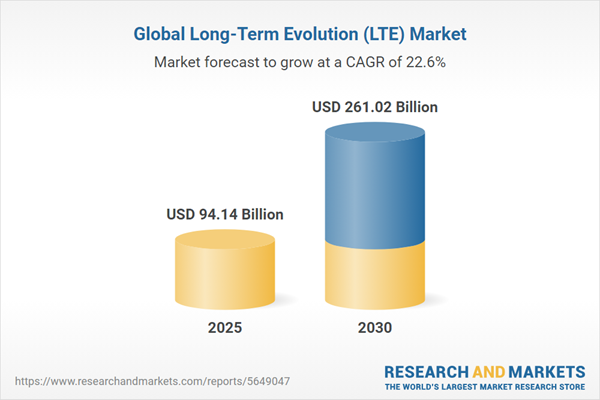The Long-Term Evolution (LTE) market is experiencing robust growth, driven by the global surge in digitalization and the increasing demand for high-speed mobile data. LTE networks, known for their high data rates and improved spectral efficiency, are critical for supporting data-intensive applications like streaming, gaming, and cloud-based services. This report analyzes key market drivers, regional dynamics, and significant developments from 2023 onward, providing insights for industry experts navigating this dynamic sector.
Market Drivers
Rising Demand for High Data Usage
The escalating need for high-speed internet, particularly among millennials and Gen Z, is a primary driver of the LTE market. The proliferation of mobile devices and the demand for seamless, high-quality audio and video streaming are fueling LTE adoption. LTE networks offer faster upload and download speeds compared to earlier technologies, enabling uninterrupted access to data-heavy applications. This trend is particularly pronounced in consumer and industrial applications, where reliable, high-speed connectivity is essential for digital transformation and operational efficiency.Proliferation of Connected Devices
The rapid increase in internet and mobile users, especially in developing regions, is boosting LTE market growth. The rise of IoT and edge computing further amplifies the need for robust LTE networks to support a growing number of connected devices. LTE’s ability to handle high data traffic with low latency makes it a cornerstone for emerging technologies, ensuring seamless connectivity for applications ranging from smart homes to industrial automation.Geographical Outlook
North America: Market Leader
North America, particularly the United States, is projected to dominate the LTE market due to significant investments in network infrastructure and high consumer reliance on mobile data. The U.S. is driven by demand for high-speed connectivity for streaming, cloud services, and IoT applications. Telecom operators are expanding LTE coverage through initiatives like deploying additional cell towers and optimizing network performance. Canada is also witnessing growth, fueled by government efforts to bridge the digital divide and expand 4G LTE coverage, supporting advanced communication technologies.Asia Pacific: Rapid Expansion
The Asia Pacific region is a key growth hub, with countries like China, Japan, and India leading LTE adoption. Rapid urbanization, industrial growth, and increasing smartphone penetration are driving demand for high-speed mobile broadband. Investments in 4G and 5G infrastructure, coupled with consumer preferences for data-intensive applications, are propelling the market forward. LTE’s role as a complementary technology to 5G ensures its continued relevance in the region.Key Developments
In September 2023, eLichens and Sequans partnered to launch an upgraded Avolta NGD (Natural Gas Detector) using NB-IoT/LTE-M technology, leveraging Sequans’ Monarch-2 SiP platform for enhanced IoT connectivity. This development highlights LTE’s growing role in specialized IoT applications. Additionally, telecom operators are integrating LTE with 5G ecosystems to ensure seamless connectivity, particularly in regions with developing 5G infrastructure.Key Benefits of this Report:
- Insightful Analysis: Gain detailed market insights covering major as well as emerging geographical regions, focusing on customer segments, government policies and socio-economic factors, consumer preferences, industry verticals, and other sub-segments.
- Competitive Landscape: Understand the strategic maneuvers employed by key players globally to understand possible market penetration with the correct strategy.
- Market Drivers & Future Trends: Explore the dynamic factors and pivotal market trends and how they will shape future market developments.
- Actionable Recommendations: Utilize the insights to exercise strategic decisions to uncover new business streams and revenues in a dynamic environment.
- Caters to a Wide Audience: Beneficial and cost-effective for startups, research institutions, consultants, SMEs, and large enterprises.
What do businesses use our reports for?
Industry and Market Insights, Opportunity Assessment, Product Demand Forecasting, Market Entry Strategy, Geographical Expansion, Capital Investment Decisions, Regulatory Framework & Implications, New Product Development, Competitive IntelligenceReport Coverage:
- Historical data from 2022 to 2024 & forecast data from 2025 to 2030
- Growth Opportunities, Challenges, Supply Chain Outlook, Regulatory Framework, and Trend Analysis
- Competitive Positioning, Strategies, and Market Share Analysis
- Revenue Growth and Forecast Assessment of segments and regions including countries
- Company Profiling (Strategies, Products, Financial Information, and Key Developments among others).
Segmentation:
By Mode
- FDD (Frequency Division Duplex)
- TDD (Time Division Duplex)
By Technology
- LTE OFDM (Orthogonal Frequency Division Multiplex)
- LTE MIMO (Multiple Input Multiple Output)
- LTE SAE (System Architecture Evolution)
By Application
- Audio/Video Telephony
- Live TV
- Browsing
- Gaming
- Sharing
By End-User Device
- Smartphones
- Tablets
- Laptops
By Geography
- North America
- United States
- Canada
- Mexico
- South America
- Brazil
- Argentina
- Others
- Europe
- Germany
- France
- United Kingdom
- Spain
- Others
- Middle East and Africa
- Saudi Arabia
- UAE
- Israel
- Others
- Asia Pacific
- China
- Japan
- India
- South Korea
- Indonesia
- Taiwan
- Others
Table of Contents
Companies Mentioned
- ZTE
- Samsung
- Fujitsu
- Cisco
- Qualcomm
- Nokia
- Motorola Solutions, Inc.
- HUAWEI
- Ericsson
- Juniper Networks
- AT&T Inc.
- Vodafone Inc.
Table Information
| Report Attribute | Details |
|---|---|
| No. of Pages | 145 |
| Published | July 2025 |
| Forecast Period | 2025 - 2030 |
| Estimated Market Value ( USD | $ 94.14 Billion |
| Forecasted Market Value ( USD | $ 261.017 Billion |
| Compound Annual Growth Rate | 22.6% |
| Regions Covered | Global |
| No. of Companies Mentioned | 12 |









